 |
 |
 |
 |
 |
 |
 |
 |
 |
 |
 |
 |
 |
 |
 |
 |
 |
 |
 |
 |
 |
 |
 |
 |
 |
 |
 |
 |
 |
 |
 |
 |
 |
 |
 |
 |
 |
 |
 |
 |
 |
 |
 |
 |
 |
 |
 |
 |
 |
 |
 |
 |
 |
 |
 |
 |
 |
 |
|
|
This page details the elements from Neon to Hydrogen. |
|
|
|

|
|
|
You are visitor |
|
|
|
|
|
Since 2/2/2005 |
|
|
|
|
|
|
|
|
This is a full Neon atom. Reactivity appears to be related to how well an atom forms alpha particles which in this model would correspond to any grouping of 4 black and 4 red cubes to form a cube. This is also the structure of a Helium atom. According to this definition, you would think that the middle part of the atom would be reactive. However, since the parts which are sticking out could be considered to be part of overlapping alpha particles with 2 alpha particles side by side (running from lower-left to upper right) or top to bottom. So all particles are involved in an alpha particle structure and this is not reactive. |
|
|
|
|
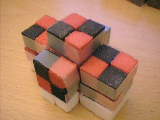 |
|
|
|
|
|
|
This is a Flourine atom. This is created by dropping off the right hand side of Neon. No matter how we think about it, this cannot be made up of alpha particle groupings and the right hand side will be extremely unbalanced. To regain balance, it will want to attach to another atom that can donate the parts necessary to form an alpha particle on the right side. For example, another Flourine atom could connect to restore the balance. This is how Flourine forms binary Flourine molecules. |
|
|
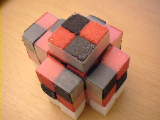 |
|
|
|
|
|
|
This is an Oxygen atom. This is created by dropping off the back side of Flourine. Now we have 2 locations that can't possibly be part of an alpha particle. This explains Oxygen's tendency to attract 2 other atoms to form compounds like H2O. Bonding would expected to be at nearly 90 degree angles. It is not unexpected that if the atoms which combine with Oxygen repel each other (like Hydrogen) that the bonds would be somewhat larger. |
|
|
 |
|
|
|
|
|
|
This is a Nitrogen atom. This is created by dropping off the backside of Oxygen. Now we have 3 locations which cannot correspond to alpha particles and serve as binding sites. This shape would suggest atoms attaching to Nitrogen would form a T shape instead of a triagonal or near tetrahedral shape (current accepted shape). However such a shape would explain the large dipole moment of compounds such as NH3, since there would be an imbalance of hydrogens on one side of the atom.. |
|
|
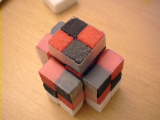 |
|
|
|
|
|
|
This is a carbon atom. This is created by dropping off the front of Nitrogen. This would suggest that there should only be 2 bonding sites. But we know that carbon has 4, so it is supposed that the top and bottom can also serve as bonding sites. This may be due to the loss of symmettry from not being able to form alpha particles through the horizontal portion of the atom. This would suggest that carbon can form linear bonds when using the top and bottom (as in CO2) or can form 90 degree bonds using the other 2 binding sites. However we know that Carbon forms tetrahedral bonds so it is supposed that the top and bottom bonds bend towards each other to form a tetrahedral bonding pattern. Evidence of this would be supported if it could be shown that the binding energies when creating a molecule like CCl4 came in 2 distinct values. |
|
|
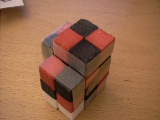 |
|
|
|
|
|
|
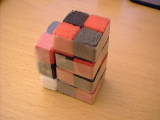 |
|
|
|
This is a Boron atom. This is created by dropping off the front side of Carbon. The reduces the total binding sites to 3. It is presumed that the top/bottom bonds bend towards each other to form a trigonal bond pattern. |
|
|
|
|
|
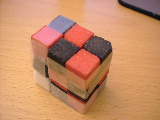 |
|
|
|
This is a Beryllium atom. This is created by removing the top of the Boron atom. This has 2 binding sites and the shape would suggest that this would not form linear componds like CO2. This is consistent with the observation that Beryllium forms high angle tetrahedral bonds. |
|
|
|
|
|
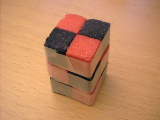 |
|
|
|
This is a Lithium atom. This is created by removing the back side of Beryllium. This only has 1 possible non-alpha particle bonding location. |
|
|
|
|
|
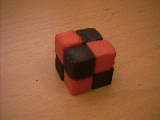 |
|
|
|
This is a complete Helium atom. This is a highly stable and unreactive arrangement. All other atoms are built out of groups of these Helium atoms (also referred to as alpha particles) and Deuterium atoms. |
|
|
|
|
|
This is a Deuterium atom. This is an isotope of hydrogen which contains a proton, electron and a neutron. The neutron is a special bound state of a proton and an electron. So the left side of the atom could be thought of as the free proton and electron, while the right black and red cube can be considered to be a neutron. All atoms can be thought of as consisting of Helium and Deuterium atoms. The difference between each element in the periodic table is one Deuterium atom. |
|
|
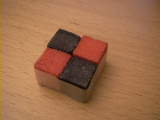 |
|
|
|
|
|
|
 |
|
|
|
This is a Hydrogen atom. This is the very simplest atom. This model would predict that Hydrogen is very polar even when not in the presence of electrostatic or magnetic fields. |
|
|
|
|
|
This is a picture of a carbon monoxide molecule. The Carbon atom is on the left and the Oxygen molecule is on the right. Notice how the black/white squares match up between the atoms and how the bond completes a Helium atom between the two atoms. This is how atoms "dock" into each other to form more complex molecules. Each of the unmatched Deuterium particles in the atoms act as a docking port for other atoms. |
|
|
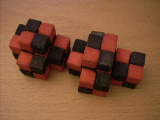 |
|
|
|
|
|
|
 |
|
|
|
This is a benzene molecule. The structure of benzene is trival in the cubic model. Each carbon bonds with it's neighbor by mutual attraction of the red/black cubes. It also appears to bond towards the center of the atom using the portion which sticks out toward the middle. The carbon atom is flipped every other atom around the ring. The hydrogen atom bonds on the remaining exposed vertice of the atom and is shown with 3 on top and 3 on bottom. |
|
|
|
|
|
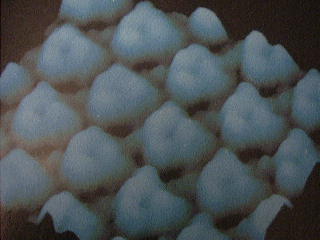 |
|
|
|
This is an actual picture of benzene molecules from a scanning tunnelling microscope. The regular pattern of 3 bumps corresponding to the attached hydrogen atoms shows up as expected according to the cubic model. |
|
|
|
|
|
The solution of the benzene molecule shows that rather than there being a resonance of double and single bonds, the bond forms with 1 complete touching bond and another weaker bond formed by near-by, but not touching deuterium particles. We can see how we can really get 1 1/2 bond without resorting to thinking the bond is somehow a combination of single and double bonds. |
|
|
|
Click here to view the noble elements |
|
|
|
Click here to return to the original cubic atomic model page |
|





























